- Yokohama-shi Top Page
- Disaster prevention and emergency services
- First aid
- Method of first aid, etc.
- If you see a fallen person
Here's the text.
If you see a fallen person
Last Updated August 11, 2020
Points to keep in mind for infection prevention
With the recent spread of COVID-19 infection, I think that many citizens are living with anxiety.
If you happen to be present in a situation where first aid is required, keep the following points in mind to prevent infection.
In addition, in the lifesaving training currently being conducted, the guidance method is based on this content.
●When checking consciousness and breathing, make sure that the face of the fallen person and the face of the person giving first aid are too close.
●Before performing chest compressions, cover any handkerchiefs, towels, masks, etc. on the mouth and nose of the fallen person.
●If the fallen person is an adult, perform chest compressions and electric shock with AED without artificial respiration.
●If the fallen person is a child, take a training course on artificial respiration, and if you are willing to do so, perform artificial respiration along with chest compressions and electric shock by AED.
●After taking over to the rescue squad, immediately wash your hands and face thoroughly with soap and running water, and if there is a handkerchief on a fallen person, do not touch it and ask the rescue squad to dispose of it Please give me.
If you see a fallen person (cardiopulmonary resuscitation procedure, how to use AED)
Video of the flow of life-saving measures
Planning and production: Noge Printing Co., Ltd.
Supervised: City of Yokohama, Fire Bureau
Flow of Lifesaving Measures
1.Confirmation of safety
If someone witnesses a sudden drop or finds a fallen place, check the safety of the surroundings before approaching.
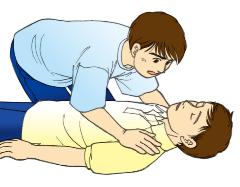
Confirmation of reaction
2.Confirmation of reaction
Tap your shoulder lightly while saying "Is it okay?" In the case of a traffic accident, do not shake your body or move your neck significantly.
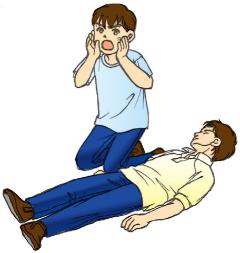
Call for help
3.Scream loudly and call for support (call 119 and arrangement of AED)
"Someone come! A person is falling down! " And shouts loudly to call the person.
4.Make a 119 call to arrange an AED
If there is a cooperator, we will call 119 and arrange for AED. If there is no cooperator, first make a 119 call yourself. The same is true for children and baby/infant.

See breath
5.See breath
Observe if you have breathing as usual. If the chest and abdomen are not moving, it will be judged that breathing has stopped.
Reference: Breathing during death.
Immediately after sudden cardiac arrest, you may see intermittent breathing called death-stage breathing If the chest and abdomen are not as usual, judge cardiac arrest and perform chest compressions immediately.
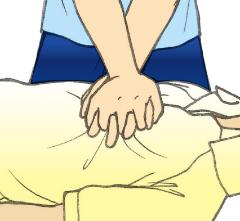
Position of chest compressions
6.Perform chest compressions (heart massage).
- Lie on your back in a flat, hard place, and stand on your knees next to it.
- Place the base of both hands in the middle of the chest (the left and right middle, and the upper and lower middle).
- Stretch your elbows, put weight on the base of your hand, and press the victim's chest so that it sinks about 5 cm.
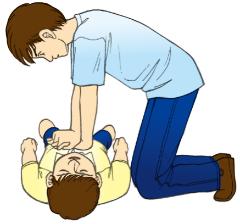
Chest compression posture
Point of chest compressions
- Strong (approximately 5 cm for adults and about 1/3 of chest thickness for children)
- Fast (100 to 120 times per minute)
- Continuously (minimize interruption)
If artificial respiration is possible, add artificial respiration to chest compressions at 30:2. If artificial respiration is not possible or hesitant, only perform chest compressions.
Reference: If the victim is a child
- In the case of children, both hands or one hand is acceptable.
- For baby/infant (under 1 year old), press the middle of the chest with two fingers (medium finger and ring finger).
- The strength of compression is about one-third of the thickness of the chest.
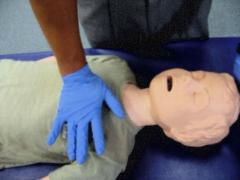 Chest compression with one hand
Chest compression with one hand
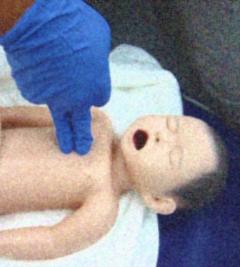 Chest compressions with two fingers
Chest compressions with two fingers
7.Perform artificial respiration (can be omitted)
After 30 chest compressions, secure the airway and perform artificial respiration twice.
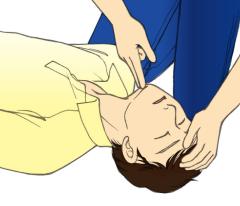
Secure airways
(1) Secure airways
Hold the victim's forehead with one hand and lift the fingertips of the other hand to the tip of the victim's chin or the hard part of the bone. The method of spreading the inside of the victim and securing the air passage through such a movement is called the "head back bending chin fist method".
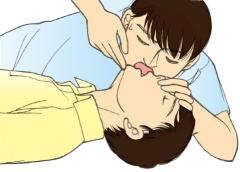
Artificial respiration
(2) Artificial respiration
With the airway secured, pinch the victim's nose with the forefinger with the thumb of the hand on the forehead. Cover the victim's mouth with your own mouth, blow it in for a second, and make sure your chest swells lightly. I'll do this twice. (Twice regardless of success or failure) As soon as you finish, move on to chest compressions.
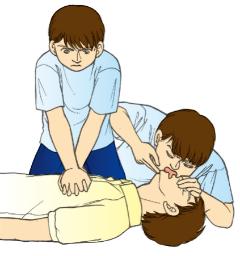
Repetition of chest compressions and artificial respiration
8.Repetition of chest compressions and artificial respiration (CPR)
- After 30 chest compressions, give 2 rescue breaths.
- Repeat the combination of 30 chest compressions and 2 rescue breaths until rescue teams and AEDs arrive.
Reference: If there is another person to help me
If you get tired, the compression will be weakened or the tempo will be slowed without noticing, so the role will be changed in about 1-2 minutes.
9.When the AED arrives, turn on the power and attach the electrode pad.
As soon as the AED arrives during cardiopulmonary resuscitation, start preparing the AED immediately. When the AED is turned on, it can be used by voice messages and lamps.
It will tell you what to do, so be calm and operate.
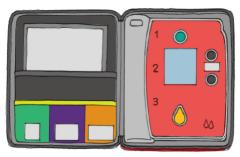
Example of AED
(1) Turn on the power
Open the AED lid and press the power button. (Some models turn on the power automatically when you open the lid.)
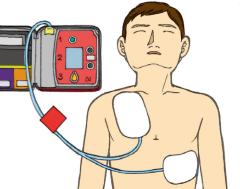
The position to attach the pad
(2) Apply electrode pads
Remove the pad from the bag and attach the electrode pad to the victim's chest.
(3) Analysis of ECG
When the pad is applied, the ECG analysis automatically starts.
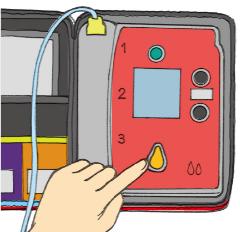
Press the shock button
(4) Resuming electric shock and cardiopulmonary resuscitation
- When the message "I need an electric shock", make sure that no one is touching the victim and press the shock button.
- Immediately resume cardiopulmonary resuscitation from chest compressions when the message "no shock is required."
Notes
- AEDs may contain two types of pads for adults and children. Adult electrode pads should not be used for children or older, and should not be used for children. Children before entering elementary school (preschool children) use this if they have electrode pads for children.
- If the victim's chest is wet, wipe it off with a towel and paste the pad.
- If a cardiac pacemaker or defibrillator is implanted, or if there is a protrusion on the chest, avoid the pacemaker and attach the electrode pad.
Inquiries to this page
Emergency Guidance Division, Fire Bureau Emergency Department
Telephone: 045-334-6797
Telephone: 045-334-6797
Fax: 045-334-6710
Email address: sy-kyukyushido@city.yokohama.lg.jp
Page ID: 157-243-285







